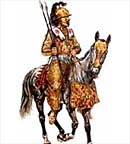 We have been discussing the historical accuracy of many classical sources on my Imperial Rome discussion group and it reminded me of the problems with some of the numbers Herodotus quotes in his "Histories".
We have been discussing the historical accuracy of many classical sources on my Imperial Rome discussion group and it reminded me of the problems with some of the numbers Herodotus quotes in his "Histories".
Even though Herodotus is often referred to as the father of history, I know many historians are skeptical about much of his narrative. One issue that seems to draw their incredulity is Herodotus’ statement of the size of Xerxes invasion force. Herodotus relates that Xerxes counted his troop strength by having 10,000 men pack themselves tightly into a circle. A circle was then drawn around them and successive groups of men were then herded into the circle until the entire army was counted. Herodotus reports the total at over one million. Historians say this would have been impossible.
Later, Herodotus recounts a conversation between Xerxes and Demerotus, the exiled Spartan king, about the fierceness of the resistance the Lacedaemonians would present. Xerxes exclaims that even if the Lacedaemonians fielded 5000 men, the Persians would still outnumber them 1,000 to 1. A little quick math returns the total this time of 5 million.
As the Persians marched through the countryside, Greek kings that had provided the token submission of earth and water to the great king were asked to feast the army for one night as the army passed through their country. Herodotus reports that the kings each had to expend a total of 400 talents of silver to provide enough food for the army and golden dinnerware for the king. He reported that each client king had to collect grain and livestock to feed this massive host. Now, if you knew the average cost of grain, goats, chickens, etc., you could probably devise still a third number based on a man’s average food consumption for a meal.
 "The £50 million film,
"The £50 million film,  I was particularly interested to note that George Clooney may be the next Leonidas. I’ve heard rumors about Hollywood making “Gates of Fire” but hadn’t seen anything about it for months. Maybe there is hope for it yet. I was also interested to see that Essex’s book “Kleopatra” is being considered for the screenplay treatment as well. My sister bought me the book a couple of Christmases ago but it is still in my “to read” pile.
I was particularly interested to note that George Clooney may be the next Leonidas. I’ve heard rumors about Hollywood making “Gates of Fire” but hadn’t seen anything about it for months. Maybe there is hope for it yet. I was also interested to see that Essex’s book “Kleopatra” is being considered for the screenplay treatment as well. My sister bought me the book a couple of Christmases ago but it is still in my “to read” pile.
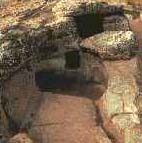 In the first of a series of articles that the Lebanaon newspaper, The Daily Star, will publish on an ongoing basis with the cooperation of the American Schools of Oriental Research, the leading North American scholarly body for the study of the ancient Middle East, Professor Larry G. Herr of Canadian University College describes ancient burials found in one of the few preserved dolmens in Jordan.
In the first of a series of articles that the Lebanaon newspaper, The Daily Star, will publish on an ongoing basis with the cooperation of the American Schools of Oriental Research, the leading North American scholarly body for the study of the ancient Middle East, Professor Larry G. Herr of Canadian University College describes ancient burials found in one of the few preserved dolmens in Jordan.
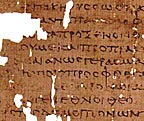 "Cyprus's national theater company, Thoc, plans a modern-day world premiere of Aeschylus's Trojan War story Achilles in Cyprus next summer. The play will then be performed in Cyprus and Greece.
"Cyprus's national theater company, Thoc, plans a modern-day world premiere of Aeschylus's Trojan War story Achilles in Cyprus next summer. The play will then be performed in Cyprus and Greece.
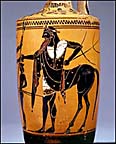 "The centaur, the mythic being with the body of a horse and the head and torso of a man, is the star of a new exhibit at the Princeton University Art Museum, but satyrs (part horse, rather than goat, in early Greek art), sphinxes (winged lions with human heads), sirens (half bird) and gorgons (who had serpentine hair) also have leading roles. Those we know by their proper names also have cameo parts, like the bull-headed Minotaur, the goat-man Pan and Typhon, the embodiment of wind and fire, who had wings and a serpent's lower body.
"The centaur, the mythic being with the body of a horse and the head and torso of a man, is the star of a new exhibit at the Princeton University Art Museum, but satyrs (part horse, rather than goat, in early Greek art), sphinxes (winged lions with human heads), sirens (half bird) and gorgons (who had serpentine hair) also have leading roles. Those we know by their proper names also have cameo parts, like the bull-headed Minotaur, the goat-man Pan and Typhon, the embodiment of wind and fire, who had wings and a serpent's lower body.
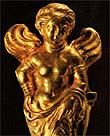 "The fate of the
"The fate of the  I saw an interesting program Sunday night on the Discovery Channel about the real Jason and the Argonauts. Apparently, Greek archaeologists have excavated what they think is the site of Jason’s city. Although ancient Colchis is believed to have had timber forts that have not survived to the present day, archaeologists excavating an early Greek colony dated to several centuries after the mythical journey in Georgia (ancient Colchis), speculate that it must have been preceeded by a much earlier interaction between the cultures that would coincide with the period that Jason’s quest supposedly took place.
I saw an interesting program Sunday night on the Discovery Channel about the real Jason and the Argonauts. Apparently, Greek archaeologists have excavated what they think is the site of Jason’s city. Although ancient Colchis is believed to have had timber forts that have not survived to the present day, archaeologists excavating an early Greek colony dated to several centuries after the mythical journey in Georgia (ancient Colchis), speculate that it must have been preceeded by a much earlier interaction between the cultures that would coincide with the period that Jason’s quest supposedly took place.